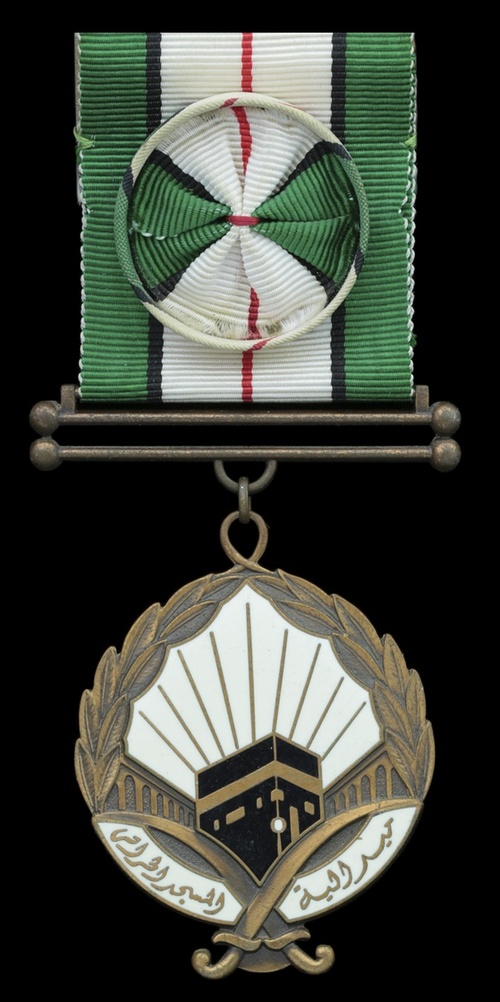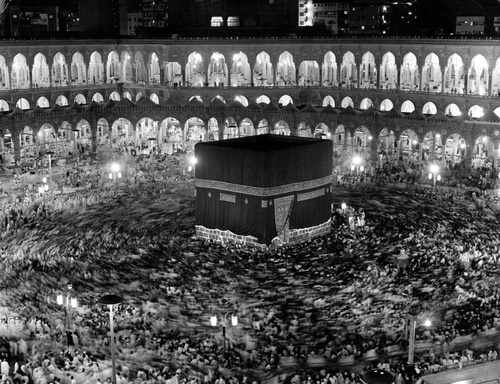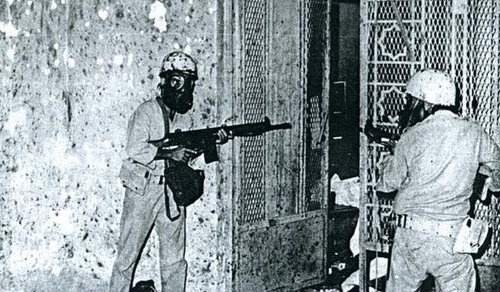Auction: 22003 - Orders, Decorations and Medals
Lot: 568
Saudi Arabia, Holy Mosque Medal, 1st Class with rosette upon riband, 40mm, bronze and enamel, good very fine and rare, mounted as worn
The pilgrimage or Hajj is one of the five pillars of Islam and pilgrims visit the holiest shrine of Islam the Holy Mosque at Mecca. After the Hajj of 1979, on the 20th of November, corresponding to 1st Muharram, the first day of the Hejira year of 1400, under the leadership of Juhayman Bin Saif Al Otaibi, various fundamentalists of Saudi and Middle Eastern origin seized control of in the Holy Mosque. At this time Al Otaibi proclaimed that the Mahdi had come in the person of Mohammed Bin Abdullah Al Qahtaini and that all the pilgrims present should acknowledge him as their leader.
The Mahdi or "the right guided one" is a figure from the Hadith or traditions of Islam. Whilst the name Mahdi is not referred to in the Koran, the phrase, "the princes will corrupt the earth and one of my people will be sent back to bring justice" is believed to foretell the coming of such a person. This coming was to be marked by violence and the shedding of blood. The Mahdi would claim descent from the Prophet Mohammed and such an event would occur at the beginning of a new Hejira century. Indeed a similar claim had been made by a Mohammed Ahmed in the Sudan in the 1880's, which resulted in the British campaign to suppress him and his followers.
Al Qahtani who claimed descent from the Prophet on his mother's side, was an ex student of Islamic law and was married to Al Otaibi's sister. Al Otaibi claimed that God had come to him in a dream and told him to proclaim Mohammed as the Mahdi. Once the proclamation had been made Al Otaibi had hoped for the support of the multitude of pilgrims present at the Holy Mosque but in the event none was forthcoming.
The taking of the Holy Mosque, a 38 acre complex, appears to have been well planned as the militants, many of whom had military backgrounds, were well armed with machine guns, anti-aircraft guns, as well as various other weapons such as AK47 assault rifles, 0.22 calibre rifles and pistols. These, it would appear, had been brought into the Holy Mosque earlier that day in seven trucks bearing the logos "Permanent Construction Co. Bin Laden", under the guise of construction work vehicles. Similarly the militants were well provisioned with dates and water, being supplied with plentiful reserves of the Holy Zamzam water from the well in the Holy Mosque. Whilst it is believed that their numbers were up to some 1,200 a more realistic estimate was between 200 and 300.
Once the militants had consolidated their position the following demands were made:
1. Oil supplies to the United States of America were to cease.
2. Radio and television services within the Kingdom were to cease.
3. The employment of women should cease.
4. Price controls were to be introduced.
5. Moral values were to be re-instated and all Shariah (the law as laid out in the Koran) decrees were to be thoroughly implemented.
All of the above were accompanied by numerous statements denouncing immoral activities by the ruling House of Saud. It would appear that the militants were motivated by a mistrust of the apparent westernisation and modernisation of Saudi Arabia and were concerned as to the direction that Saudi society was going.
Initially the response to the storming of the Holy Mosque was restrained. It is forbidden to shed blood within the confines of the Holy Mosque. This being so King Khalid Bin Abdulaziz Al Saud obtained a ruling from the religious authorities that following the failure of reasoned dialogue to resolve the situation that force could be used. The Holy Mosque was then stormed by Government Forces. After a drawn out and bloody assault and piecemeal retaking of the Holy Mosque complex, it was almost two weeks later that the Interior Minister Prince Naif Bin Faisal Bin Abdulaziz Al Saud declared that the Holy Mosque was liberated at 1.30 am on Sunday 4 December, with the final stages of the fighting having taken part in the cellar complex of the Holy Mosque.
According to the official Saudi Government statement the following casualties occurred:
Saudi personnel killed -130.
Saudi personnel injured - 461, of whom 27 later died.
Militants killed - 75.
Militants captured - 170 (also 23 women and 16 boys).
Pilgrims killed - 27, including 3 women.
It is believed that some, if not many, of the militants escaped. Amongst the dead was the proclaimed Mahdi who, it is claimed, committed suicide. The body of Al Qahtani was then publicly displayed to disprove the claims that the Mahdi had come. The prisoners, including Al Otaibi, were then tried and dispatched in groups around the Kingdom they were publicly beheaded.
The Medal was instituted by Council of Ministers Decree of 11/01/1401 H (19 November 1980) and manufactured by Arthus Bertrand of Paris.
This Medal was principally awarded to those troops who took part in the battle to retake the Holy Mosque in Mecca and the recipients consisted mainly of the following, the National Guard, the Royal Saudi Army and the Royal Saudi Air Force. It not believed that awards of the medal were made to any foreign personnel, such as instructors, involved in the operation.
With thanks to Owain Raw-Rees for his research in producing the above details on this award.
Subject to 20% VAT on Buyer’s Premium. For more information please view Terms and Conditions for Buyers.
Sold for
£250
Starting price
£50









